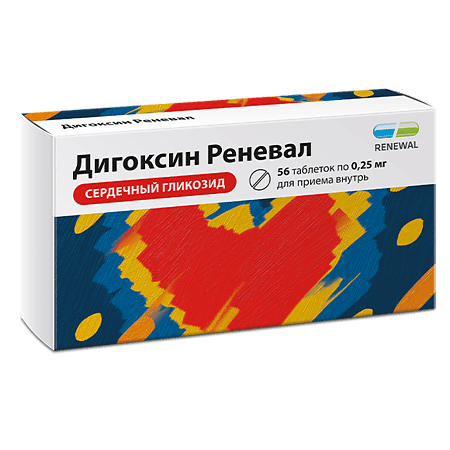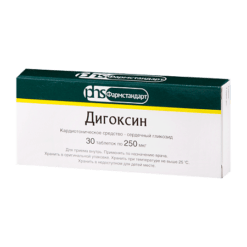No products in the cart.
Digoxin Reneval, tablets 0.25 mg 56 pcs
€2.24 €1.87
Description
Pharmacodynamics
Digoxin is a cardiac glycoside. It has a positive inotropic effect due to the direct inhibitory effect of sodium-potassium ATPase of cardiomyocyte membranes, which leads to an increase in intracellular sodium ions content and, consequently, a decrease in potassium ions.
Increased content of sodium ions causes activation of sodium-calcium metabolism, increased content of calcium ions, resulting in increased myocardial contractility. As a result of increased myocardial contractility, the stroke volume of blood increases. The final systolic and final diastolic volumes of the heart decrease, which, along with an increase in myocardial tone, leads to a reduction in myocardial size and thus reduces myocardial oxygen demand.
It has a negative chronotropic effect, reduces excessive sympathetic activity by increasing the sensitivity of cardiopulmonary baroreceptors. By increasing the activity of the vagus nerve, it has an antiarrhythmic effect due to the decrease in the rate of impulse conduction through the atrioventricular node and prolongation of the effective refractory period. This effect occurs as a result of mediated action on the atrioventricular node.
Negative dromotropic effect is manifested by increased refractoriness of the atrioventricular node, which determines the use in paroxysms of supraventricular tachycardia and tachyarrhythmias.
In atrial fibrillation it helps slow down the rate of ventricular contractions, prolongs diastole, improves intracardiac and systemic hemodynamics. The positive butotropic effect is manifested at subtoxic and toxic doses.
It has a direct vasoconstrictor effect, which is most clearly manifested in the absence of peripheral edema stasis. At the same time, the indirect vasodilatory effect (in response to an increase in the minute blood volume and reduction of excessive sympathetic stimulation of vascular tone) usually prevails over the direct vasoconstrictor effect, resulting in a decrease in total peripheral vascular resistance.
Pharmacokinetics
Absorption of digoxin from the gastrointestinal tract is variable, is 70-80% of the dose and depends on the motility of the gastrointestinal tract, drug form, concomitant ingestion, interaction with other drugs. Bioavailability is 60-80 %.
Under normal gastric acidity a small amount of digoxin is destroyed, under hyperacidic conditions more of it may be destroyed. For complete absorption sufficient intestinal exposure is required: with decreased motility of the gastrointestinal tract bioavailability is maximum, with increased peristalsis – minimum.
The ability of digoxin to accumulate in tissues (cumulate) explains the lack of correlation at the beginning of treatment between the severity of pharmacodynamic effect and its concentration in blood plasma. Binding with blood plasma proteins is 25%.
Apparent volume of distribution is 5 l/kg. It is metabolized in liver. It is excreted mainly by kidneys (60-80% unchanged), half-life is about 40 hours (determined by the kidney function). The intensity of renal excretion is determined by the value of glomerular filtration.
In mild chronic renal insufficiency decrease in renal excretion of digoxin is compensated by hepatic metabolism to inactive compounds. In hepatic insufficiency, compensation is due to increased renal excretion of digoxin.
Indications
Indications
Active ingredient
Active ingredient
Composition
Composition
How to take, the dosage
How to take, the dosage
Interaction
Interaction
Special Instructions
Special Instructions
Contraindications
Contraindications
Hypersensitivity to drug components, glycoside intoxication, Wolf-Parkinson-White syndrome, grade II atrioventricular block, ventricular tachycardia and ventricular fibrillation, intermittent complete block, children under 3 years of age; patients with rare hereditary diseases: Lactose intolerance, fructose intolerance, lactase, sucrose/isomaltase deficiency or glucose-galactose malabsorption.
With caution
Comparing benefit/risk: Grade I atrioventricular block, sinus node weakness syndrome without a pacemaker, possibility of unstable conduction through the atrioventricular node, history of Morgans-Adams-Stokes attacks, hypertrophic obstructive subaortic stenosis, isolated mitral stenosis with a rare heart rate cardiac asthma in patients with mitral stenosis (in the absence of tachysystolic atrial fibrillation), acute myocardial infarction, unstable angina pectoris, arteriovenous shunt, hypoxia, heart failure with impaired diastolic function (restrictive cardiomyopathy, cardiac amyloidosis, constrictive pericarditis, cardiac tamponade), extrasystole, marked heart cavity dilatation, “pulmonary” heart; water-electrolyte disorders: hypokalemia, hypomagnesemia, hypercalcemia, hypernatriemia; hypothyroidism, alkalosis, myocarditis, old age, renal and/or liver failure, obesity.
Side effects
Side effects
Comparing benefit/risk: Grade I atrioventricular block, sinus node weakness syndrome without rhythm driver, possibility of unstable conduction through the atrioventricular node, history of Morgania-Adams-Stokes seizures, hypertrophic obstructive subaortic stenosis, isolated mitral stenosis with a rare heart rate, cardiac asthma in patients with mitral stenosis (in the absence of tachysystolic atrial fibrillation),
Overdose
Overdose
Pregnancy use
Pregnancy use
Additional information
| Shelf life | 2 years. |
|---|---|
| Manufacturer | Update PFC AO, Russia |
| Medication form | pills |
| Brand | Update PFC AO |
Other forms…
Related products
Buy Digoxin Reneval, tablets 0.25 mg 56 pcs with delivery to USA, UK, Europe and over 120 other countries.


















